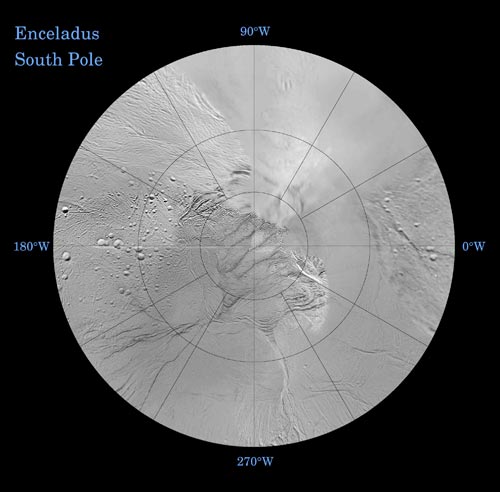“Warm temperatures” and “polar regions” are not phrases typically associated with each other. But, then again, Saturn’s icy moon Enceladus is no ordinary object.
Planetary scientists continue to analyze the rich trove of observations taken by the Cassini spacecraft as it flew within 110 miles (175 kilometers) of Enceladus’ surface July 14. As they do so, they find mounting evidence that ground fractures near the south pole vent water vapor, creating the moon’s atmosphere.
Within a minute of closest approach, two Cassini instruments discovered material emanating from the moon’s surface. At an altitude of 286 miles (460 km), the Cosmic Dust Analyzer detected a peak in the number of powder-size ice particles coming from the surface. Even closer in, at an altitude of just 168 miles (270 km), the Ion and Neutral Mass Spectrometer observed a big jump in the amount of water vapor.
By analyzing when the peaks occurred, scientists think they’ve pinpointed where both the vapor and fine particles originate: the south polar region. High-resolution images of the region show a series of roughly parallel cracks, dubbed “tiger stripes,” approximately 80 miles (130 km) long and 25 miles (40 km) apart. And Cassini’s Composite Infrared Spectrometer found the pole to be abnormally warm, some 10° Fahrenheit (5 kelvins) above the equatorial temperature. Some spots near the tiger stripes were 55° F (30 kelvins) warmer than the equator.
“Enceladus is surprisingly warm, internally fractured, and active,” says Imaging Team leader Carolyn Porco of the Space Science Institute in Boulder, Colorado. “We’re not sure how it comes to be that its south pole in the warmest, most active place. The fact that Enceladus is so alive and Mimas, the moon next door and roughly the same size, is so dead, is really testing our understanding of the internal workings of planetary satellites.”
Another Cassini instrument, the Visual and Infrared Mapping Spectrometer (VIMS), find the south polar region may have been geologically active as recently as 10 years ago. The instrument shows Enceladus’ water ice exists in two forms: pristine, crystalline ice and radiation-damaged, amorphous ice. Scientists think the process that converts fresh ice to amorphous ice takes only decades — or perhaps even less.
“There appears to be a continual supply of fresh, crystalline ice at the tiger stripes, which could have been resurfaced very recently,” says VIMS team member Bonnie Buratti of NASA’s Jet Propulsion Laboratory in Pasadena, California. “Enceladus is constantly evolving and getting a makeover.”
The recent findings underscore the advantages of a large, complex spacecraft like Cassini, which can observe an object with several instruments at the same time. But those instruments will have to take a back seat for a while. For the next few years, theorists and modelers will take center stage in trying to understand Enceladus — Cassini doesn’t make another close flyby of Enceladus until March 2008.










